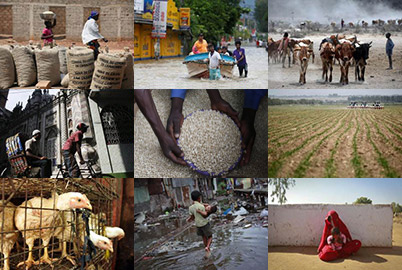Unplanned building and intense rainfall are leading to more flooding in coastal Kenya - but a new urban plan may help
MOMBASA, Kenya, June 16 (Thomson Reuters Foundation) - Saumu Juma 25, a mother of two, was conducting morning prayers in her mud-walled home when her iron-sheet roof started caving in.
She rushed to protect her sleeping children, injuring her back, ribs and head as the roof collapsed and floodwater swept into her small house.
Her son and daughter survived, after being momentarily buried in mud - but other families weren't so lucky. Two other people in nearby Kalahari slum died in the flash floods that destroyed several homes that night.
Flooding is nothing new in Mombasa County, on Kenya's coast. Some areas are inundated each year, and the region has seen big floods every few decades, including most recently in 1997.
But this year's floods were stronger than usual, something residents and environmental scientists attribute to a rise in urban populations - and to changing weather patterns.
"This year's flooding is worse as compared to previous years and this is because of development in Mombasa," said Mohammed Rajab, a programme coordinator for the Red Cross Society in Mombasa County.
But Francis Thoya, the Mombasa County Minister for Land and Housing, says shifting weather patterns are the bigger problem.
"Climate change is here and, in preparing for any major disaster, the main thing that we are factoring in is climate change. In fact, us who are in low-lying areas are going to be affected more, this is for sure," Thoya said.
Thoya and Rajab say improving urban planning will be the best way to deal with the growing flooding threat.
Mombasa, Kenya's largest coastal city, saw its last urban plan expire in 2000. As a result, rapid urbanisation has led to developers building in any available space, said Thoya, chair of the Mombasa County Disaster Management Committee.
That unplanned expansion of the city has led to the blockage of waterways that once helped drain the city during heavy rainfall, and led to water flowing in other directions, Rajab said.
To ease the problems, the city this spring began creating a new Mombasa city master plan, with $1.3 million in funding from Japan. The plan is expected to be completed in March 2017.
"It will prescribe solutions to all the problems we have with planning in the county," Thoya predicted.
The Kenya Red Cross Society has in particular been advocating for a new look at drainage systems in Mombasa, Rajab said.
Maarifa Mwakumanya, an environmental science lecturer at Pwani University, said he believes the master plan - if it is implemented - will play a big role in addressing future flooding problems.
But it will have to be developed "keeping in mind the situation that people have built all over Mombasa haphazardly," he said.
Residents of Mombasa County affected by the recent floods say they agree that new drainage systems will be the surest way to deal with the worsening problem.
Juma, who lost her house to the flooding, lives on the boundary of Mombasa Moi International Airport and "if a drainage could be built along the airport's fence, that will really help because the flood waters would not run into my home," she said.
"Our ward leader came here after the floods and said that the drainages will be dug but nothing has been done so far," said Juma, who grows cassava with her husband on their one-acre plot of land and who says her family has nowhere else to go.
While waiting for the new master plan, Thoya said the county has started fixing and unclogging the existing drainage system.
"All the major river courses which are blocked, we are going to unblock them. All the people who have constructed on these areas, they should be ready to face demolition," he said.
But Maarifa warned that such fixes will not last as long as people continue to throw trash into the area's waterways.
"There are poor waste management practices in the city so even if you unclog there is so much solid waste that goes into the drain during the rainy season, he said. An equally crucial issue, he said, is "what are we doing with our solid waste?"
(Reporting by Anthony Langat; editing by Laurie Goering : ) ;))
Our Standards: The Thomson Reuters Trust Principles.

